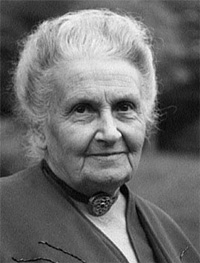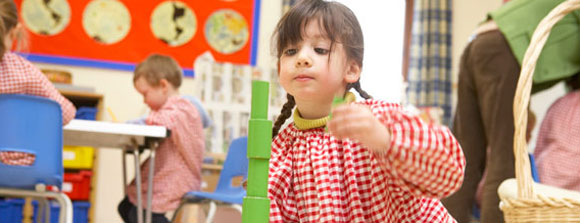The Montessori Method
 The Montessori Method was devised by Dr Maria Montessori in Italy at the turn of the 20th century. She had several key theories about the child. The child’s ability to learn comes from within – a desire to learn – because he has an absorbent mind. Children have sensitive periods of learning – at different ages the child has a desire for different stimuli. The teacher’s role is very much that of a director and observer, not telling and doing, but showing and watching. The classroom is very important. Montessori called it the ‘prepared environment’. It has 6 basic components (see opposite).
The Montessori Method was devised by Dr Maria Montessori in Italy at the turn of the 20th century. She had several key theories about the child. The child’s ability to learn comes from within – a desire to learn – because he has an absorbent mind. Children have sensitive periods of learning – at different ages the child has a desire for different stimuli. The teacher’s role is very much that of a director and observer, not telling and doing, but showing and watching. The classroom is very important. Montessori called it the ‘prepared environment’. It has 6 basic components (see opposite).
“Dr Montessori felt that the goal of early childhood education should not be to fill the child with facts from a pre-selected course of studies, but rather to cultivate his own natural desire to learn. In the Montessori classroom this objective is approached in two ways; first, by allowing each child to experience the excitement of learning by his own choice rather than by being forced; and second by helping him to perfect all his natural tools for learning so that his ability will be at a maximum in future learning situations.” — A Parent’s Guide to the Montessori Classroom by Aline D Wolf.





 The Montessori Method was devised by Dr Maria Montessori in Italy at the turn of the 20th century. She had several key theories about the child. The child’s ability to learn comes from within – a desire to learn – because he has an absorbent mind. Children have sensitive periods of learning – at different ages the child has a desire for different stimuli. The teacher’s role is very much that of a director and observer, not telling and doing, but showing and watching. The classroom is very important. Montessori called it the ‘prepared environment’. It has 6 basic components (see opposite).
The Montessori Method was devised by Dr Maria Montessori in Italy at the turn of the 20th century. She had several key theories about the child. The child’s ability to learn comes from within – a desire to learn – because he has an absorbent mind. Children have sensitive periods of learning – at different ages the child has a desire for different stimuli. The teacher’s role is very much that of a director and observer, not telling and doing, but showing and watching. The classroom is very important. Montessori called it the ‘prepared environment’. It has 6 basic components (see opposite).